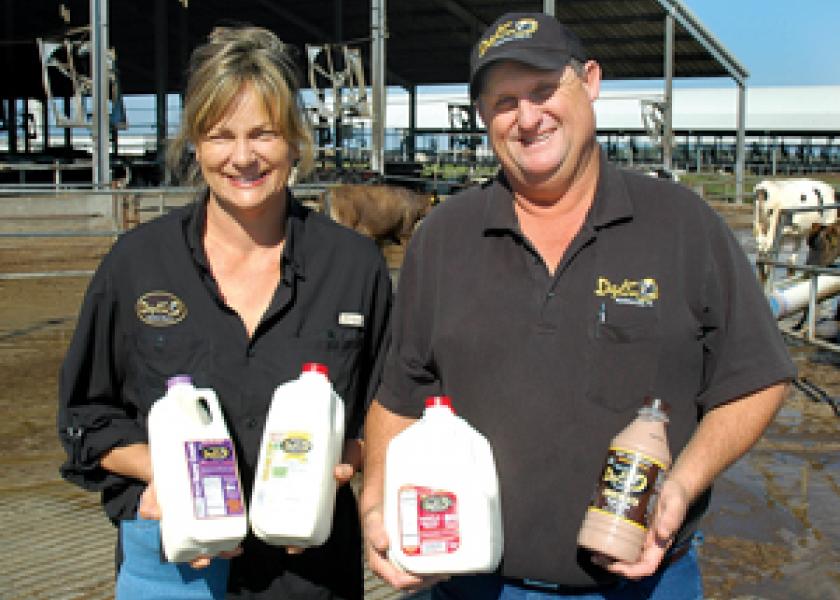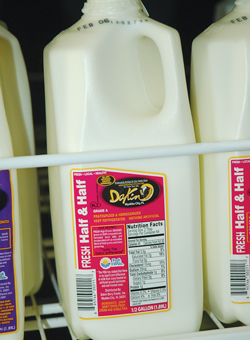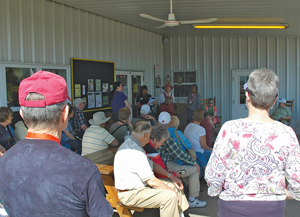Nowhere But Up

Florida Dairy vertically integrates
Grocery store fluid milk prices are the frustration of every dairy farmer—$3 per gallon for store-brand milk and $4 per gallon for a branded product translates into $35 to $45 per cwt. retail.
That frustration—and the fact that dairy co-ops and processors treat milk like a commodity—led Jerry and Karen Dakin, Myakka City, Fla., to start bottling fluid milk from their 2,100 cow herd in March 2009. The farm and plant is 45 minutes west of Sarasota on Florida’s Gulf side.
|
| More on Dakin Dairy products |
And while they’re now capturing a couple dollars per cwt. of that retail margin, their four-year slog to vertical integration has been a steep, uphill climb. "Vertical integration is quite the animal to take on—it’s quite the gorilla," Jerry says. "Processing milk makes dairy farming look easy."
"You can’t establish a market until you have the product," Karen adds. "And you can’t make the product until you have the market."
The Dakins did have one advantage. They attracted the interest of a large, natural foods retailer who was seeking a partnership with a local, "sustainable" dairy producer.
The dairy had to have some volume to supply the retailers many stores, but it didn’t have to be organic or purely pasture based. But the farm couldn’t use rBST, and its reputation for sustainability, animal welfare and labor management had to be stellar.
A Bemudaand rye grass mixture is green chopped daily as a major component of the Dakin Dairy diet—and a major selling point for Dakin Dairy products. |
The Dakins’ farm fit the bill. Cows are housed on sand-bedded freestalls. The climate in central Florida allows them to green chop forage year round.
"Our fame to glory is green chop. It’s a combination of Bermuda grass inter-seeded with rye grass," Jerry says.
Last year, the Dakins chopped over 19,000 tons of the stuff off of 400 acres, taking a cut every 28 days or so. Cows get 50 to 70 lb. of green chop each day.
And the Dakins market the heck out of this fresh, grass-fed milk that they can rightly claim has higher, year-round levels of conjugated linoleic acid and natural levels of beta-carotene and vitamins D and E. "This truly is why our milk tastes so good—it’s the ‘fresh’ grass, 365 days a year, blended with hay, grains and minerals that makes the Dakin ‘taste’ difference," proclaims their website.
"Green chopping every day gives us this real niche," Jerry says.
"Once we started processing, even I was amazed at how delicious our milk was," Karen says.
As the Dakins did their early market research, they quickly came to realize they needed to supply stores with a full line of milk products. Distributors and dairy managers weren’t going to be bothered with a niche marketer who could only supply whole milk in gallons.
So the Dakins knew they needed a processing plant that could handle gallons and half gallons of whole, 2%, 1% and fat free along with a chocolate milk offering, fresh heavy cream and half and half.
 |
The Dakin Dairy brand offers a full line of fluid milk products, displayed here in the retail farm store on the dairy. |
All this equipment doesn’t come cheap—even if much of it is used. The Dakins’ emergency generator, for example, was found on eBay. Much of the stainless steel, valves and monitoring equipment came out of fruit juice factories. Dakin budgeted $750,000 for the plant and equipment, and ended up spending $1.4 million.
The Dakins also quickly learned that glass bottles weren’t an option. "I really wanted to go to glass bottles, but that just doesn’t work because of breakage and liability," Karen says.
And then there’s the issue of bottle returns and sanitation. Glass bottles would quickly become a logistical nightmare, and the idea was almost immediately shelved.
The dream of having their own "Dakin" dairy brand was not the same pipe dream. It did, however, take several years to gain traction.
Karen figures she spent $5,000 on just developing their unique "Dakin Dairy Farm" logo with a curly cue at the end framing a Holstein cow face. It took months to develop before Karen one day drew it free hand out of frustration.
And again, having a full line of dairy products was critical for non-chain stores and restaurants to give the Dakins a foot in the door. They often gave product away the first time to get some restaurants to try their products.
Having a fresh, full-fat cream was a God-send. The only other cream available to Florida restaurants is ultra-high temperature preserved product. But once bakers try Dakins’, the cream pretty much sells itself.
Today, Dakin Dairy Farm branded products make up about half of their sales. They say having a good-tasting product underpins everything. But then having a reliable distributor who believes in your product and your own in-house marketing to support those sales is absolutely critical.
Dakins has both. Suttor’s Distributing, with its regional reach, now handles deliveries. And Dakins hired Richard Goldner, who has years of dairy marketing experience in the Florida market, to handle sales.
Even having done all that, the market will still dictate price. When the Class I price drops, store managers expect the Dakins to drop their wholesale prices as well.
"Distributors know the dairy market better than dairy farmers," Jerry says. "When the market drops 1.2¢ per gallon, the distributor wants you to drop your price 1.2¢ per gallon."
"We’ve learned that we can’t command higher prices just because we’re Dakin Dairy Farms, this local, sustainable dairy operation that everyone loves," he continues. "But we can price competitively against national brands."
He says he’s developed enough of a reputation with his stores that he isn’t forced to drop the full amount when Class I prices drop. But he does it with the understanding that he won’t increase prices the full amount either when prices skyrocket.
 |
Dakin Dairy offers guided tours of the farm for picnics and birthday parties. This group of retired farmers came in from Iowa and Missouri. |
Local brand building is also critical. The Dakins offer daily farm tours October through April, and personalized tours by appointment during the off-season. They hosted about 10,000 visitors in each of the last two years, with 75% to 80% of these schoolchildren.
"We do charge schools $8 per student because we have to have a full staff on hand to conduct the tours," Karen says. "It’s not all that profitable—in fact, I’ve had to subsidize it out of my check book."
But the Dakins believe the tours are one of the best ways to build and maintain brand identity. With some 3 million consumers in the Tampa Bay metro area, Dakin Dairy is just one of four dairies within an hour’s drive.
Marketing their own milk has come full circle to managing the dairy as well. Many Florida dairymen simply stop breeding in the heat of July and August, relying on their co-ops to import milk from up north to meet local needs. Because he now needs a steady milk supply year-round, Dakin continues to breed cows through the summer, even when conception rates dip to 15% or less.
Somatic cell counts (SCC) have also taken on new meaning. Before he processed his own milk, Dakin didn’t worry too much about SCC level. But Dakin milk now has a 20-day shelf life on the label. SCC is critical to maintaining that shelf life. His herd now averages 175,000 cells/ml.
Dakin milk is now being sold across Florida, the Virgin Islands and the Bahamas—getting it there within 48 hours after it leaves the cow.
In October, the Dakins hope to be milking another 300 cows to meet demand.
Lessons Learned The Hard Way
If you’re considering processing your own milk, Jerry and Karen Dakin offer these bullet points of advice:
- Make sure you have the dairy farming part of your business down pat. Your attention will get diverted to the processing business, and the dairy will suffer if it’s not already fine-tuned and self-sufficient.
- Have a mission statement and business plan for the business. Without either, you won’t have a sense of purpose or direction.
- Know your local market. How many consumers are in your region? What are their demographics and income levels? How many are potential customers?
- Make sure you are adequately capitalized. Have your financing locked up and lenders on board with your plan. Even used equipment costs more than most people realize.
- Visit other operations. Visit people who have both succeeded and failed at milk processing. Learn from both.
- Interview many engineers to get your plant design done correctly. Then be prepared to make changes and tweaks once you begin operations. Leave room for expansion.







